10 Most Beautiful Temples in Cambodia
Angkor, the sacred legacy left by the Khmer Empire, is high on travelers' bucket list. Located in today's Cambodia and thrived throughout the 9th to 15th centuries, the then-capital was populated by more than a million people, making it the world's largest pre-industrial city. A great number of Angkorian temples can be found across the country, and there is also a fusion of Buddhist and Hindu religious sites constructed in secluded spots. A first-time visit to Cambodia is a mind-blowing immersion in the unique temple architectures. To help get your head around what to visit, I have rounded up 10 temples of great importance in terms of historical significance and the worthiness of visit.
Siem Reap
I am not sure about others, but my first experience with Siem Reap was overwhelming: there were too many temples to see them all in just a few days! The city is like a spiritual hub, housing the Angkor Archeological Park that stretches 162.6 hectares. It is usually the first stop for first-time explorers, so I will start with the most accessible and significant ones.
Angkor Thom
Before jumping to Angkor Wat, I would suggest spending the first day venturing out to Angkor Thom, the capital city of the Khmer Kingdom made by King Jayavarman VII in the late 12th century. The square city is surrounded by high walls spanning more than seven miles long with five Gopuram gates, which are connected by a causeway adorned with stone figures of Devas.
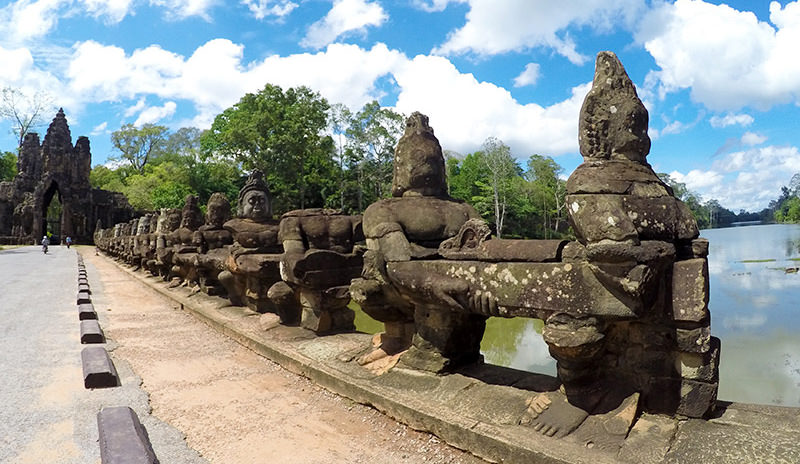 The causeway spanning the moat in front of each tower.
The causeway spanning the moat in front of each tower.
Also known as the Great City, Angkor Thom consists of a couple of famous temples and monuments. While most of the perishable building materials have already been gone, the remaining stone architectures are capable of impressing visitors in every way. At the heart of the complex stands the Bayon Temple famous for the 216 smiling faces of Avalokiteshvara, the earthly manifestation of the self-born eternal Buddha Amitabha. Located to the north of Bayon is the 350 meters long Terrace of Elephants, a beautifully carved base where the King used to view his returning army. Other significant sites include Baphuon, Terrace of the Leper King, Tep Pranan and a couple of more. It is possible to explore the whole complex by walking within a day, albeit some part of the site involves steep steps up and down.
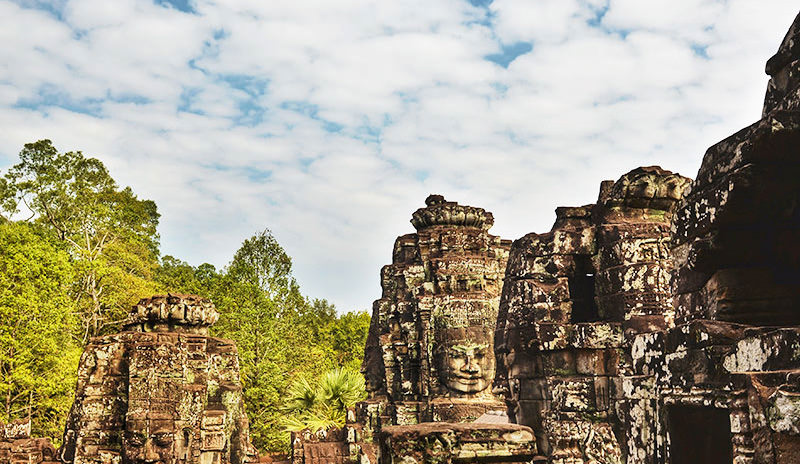 The smiling faces are carved into subtly different expressions.
The smiling faces are carved into subtly different expressions.
Angkor Wat
The national icon has made a name for itself for a reason. Surrounded by a 200 meters long moat that helps stabilize the foundation of the temple, Angkor Wat is a massive compound of more than 45 awe-inspiring temples. Thanks to the scientists striving to preserve this one of the most important archaeological sites in the world, the majestic atmosphere still lives today. It was said that King Suryavarman II constructed Angkor Wat as his mausoleum, but he died in the battle field rather than being buried in the temple site. In the centre rises the main tower that is accompanied with four towers, creating a perfect symmetry for you're your eyes and camera lens. Every wall of the temples is covered by exquisite bas-reliefs and carvings that depict Apsaras scenes, wars, Hindu legends, people's daily life as well as heaven and hell. As the weather is normally unbearably hot in Cambodia, it feels fantastic just staying in the shades of indoor corridors to enjoy the reliefs.
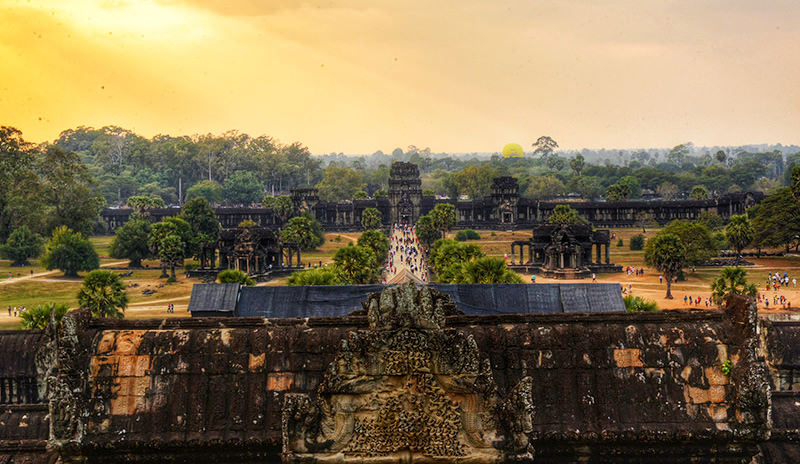 Angkor Wat sunset.
Angkor Wat sunset.
There has been a debate over whether the sunrise or the sunset in Angkor Wat is the most beautiful, but I personally think they are equally amazing (and the crowd is always there too). The best spot to watch the sunrise is from reflection ponds in front of the main temple, which experiences a game of colour when the sun casts its glow. For the sunset, it takes some efforts to climb up the Bakheng Mountain, where you will have a surreal view of Angkor Wat rising from the jungle amid intense sunset colours. Continue to read Top 10 Facts About Angkor Wat That Will Blow Your Mind.
Ta Prohm
Long carrying the fame of being one of Tomb Raider's shooting scenes, Ta Prohm has made quite an impression on world audience. The temple is recognized by having its fallen premises entwined by the giant fig vines and buttress roots, looking pretty much like a battle is going on between nature and masonry. Built entirely without mortar, Ta Prohm is a Buddhist monastery constructed in 1186. Since it was rediscovered by French archaeologists in the early 20th century, restoration work has been carrying on despite of the look of neglect. The temple now is safe to visit, with thousands of tourists flocking in every day. Ambling in and through the root-riddled structure, a deceiving hunch of getting lost would give you some chill, but at the same time, you will also succumb to the willingness of staying in this breathtakingly beautiful labyrinth.
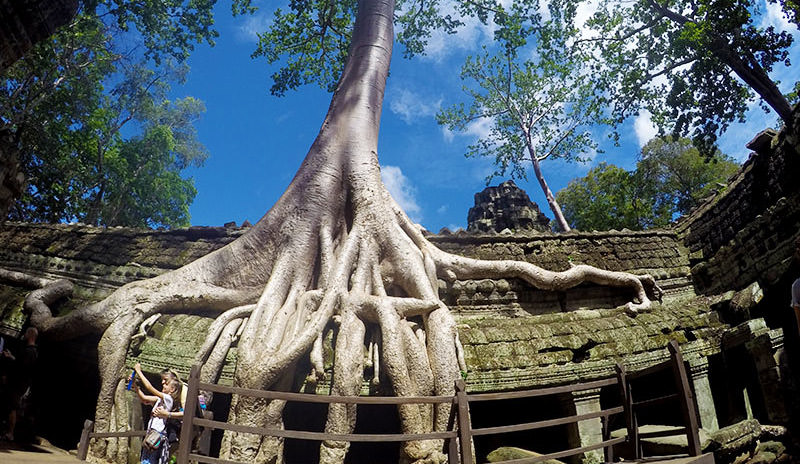 Gigantic roots taking over the temple.
Gigantic roots taking over the temple.
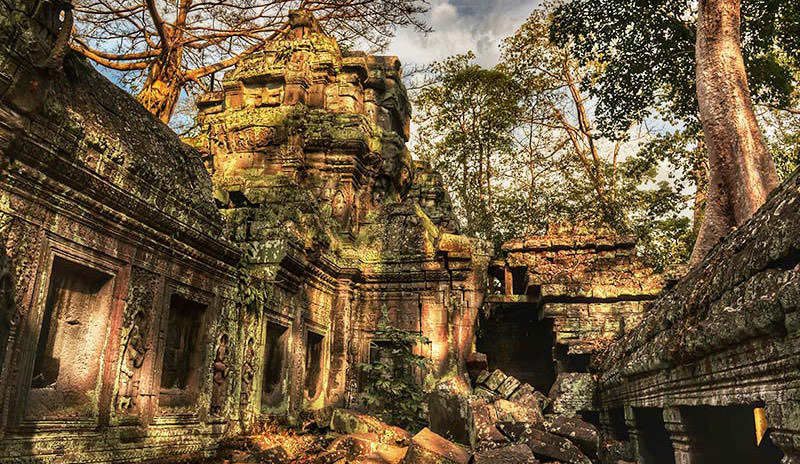 A corner where the architecture takes the upper hand.
A corner where the architecture takes the upper hand.Banteay Srei
Dating back to the 10th century, Banteay Srei was commissioned by a female Brahmin (similar to the role of a teacher or a priest) instead of a ruler, which differs it from many Angkorian temples. Also known as "the Citadel of the Women", the red-sandstone temple is dedicated to Lord Shiva and contains some of the most elaborate stone carvings in the world. It may not be comparable with Angkor Wat or Bayon when it comes to scale, but the artistry reflected from the motifs and figures of gods is beyond perfection. Because of the careful preservation, it is hard to imagine that these carvings are more than 1,000 years old. The temple is located a bit far from usual tourist tracks, nevertheless, the journey will be rewarded. With the company of a private guide and car, I got the best out of this trip – transport, interesting stories behind the scene, iced towel and bottled water… Just a perfect way to visit the ruins in a hot weather.
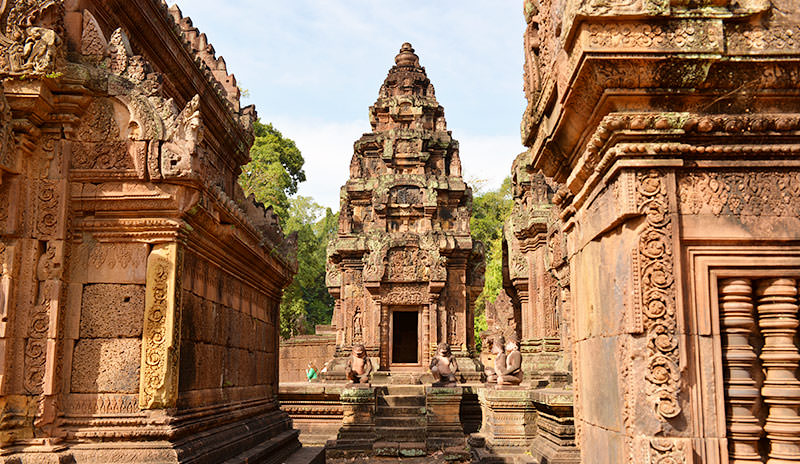 Banteay Srei is small in scale but of a high value of aesthetics.
Banteay Srei is small in scale but of a high value of aesthetics.
Beng Mealea
After seeing all the crowded attractions, Beng Mealea tops my favourite. Partly because I enjoyed the 2014 French film of Two Brothers which was shot there, but more importantly, the mystery and the unrestored state of the temple delivers an authentic Indiana Jones experience. Very few people know that Beng Mealea was constructed in the same floor plan as was Angkor Wat, but earlier and smaller than the latter. Once an active landmine field in the 1970s under the Khmer Rouge, it was reopened in 2003 after being completely cleared. Like in Ta Prohm but in a more haunting manner, dilapidation is the only term coming to my mind when I entered the low key entrance of Beng Mealea after walking over some well-preserved causeway. This quiet and peaceful site receives nothing close to restoration, giving visitors most freedom for scrabbling over the piles of stones (sneakers are a must). Building blocks are covered by moss and vegetation, the only thing alive is the weak sunlight filtering through the thick leaves of trees. If you are into less visited places and want to beat the hot weather, this is heaven.
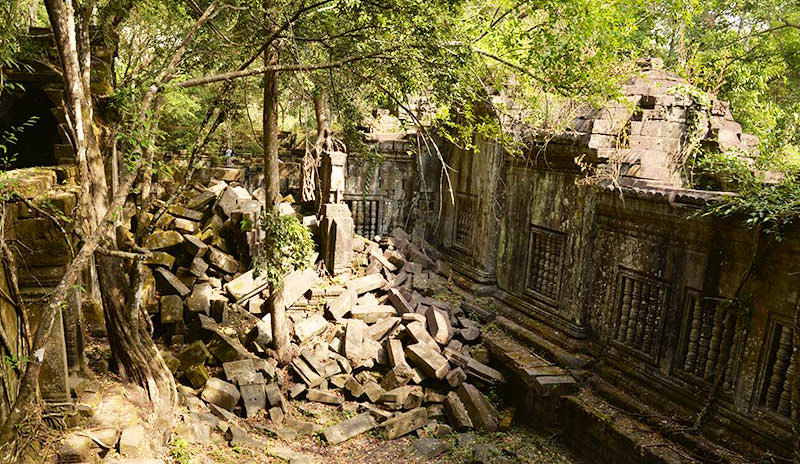 Beng Mealea is like a forgotten land that has a glorious past.
Beng Mealea is like a forgotten land that has a glorious past.
Takeo Temple
Located between the Gate of Victory of Angkor Thom and East Baray, Takeo Temple is a nice stop to admire one of the tallest temples in Cambodia commissioned by King Jayavarman V. This 5-tire pyramid-shaped structure is also the first temple built by all sandstone, reaching a total height of 40 meters. The massive sanctuaries are, however, unfinished works left at the beginning of the 11th century. The reason for the halt still remains a mystery. People speculate that it was due to the death of the King, or according to an inscription, a lightning struck the temple which was taken as a bad omen to continue the work. Either way, it led to less bas-reliefs on the walls of Takeo Temple as decorations were about to be added. The steps proving access to the top of the temple are very steep, but you are guaranteed to have a good view of the surrounding area from there.
Phnom Penh
As the capital city of Cambodia, Phnom Penh is more famous for the memorial sites left by sad historical event. Nevertheless, there are a handful of decent temples for an exploration. Among them Wat Phnom is considered the most beautiful to visit.
Wat Phnom
This Buddhist monastery sits quietly atop of the only hill in Phnom Penh, which is also a central point in the city. Wat Phnom was built in 1372 but has been rebuilt several times throughout history. The complex perfectly combines nice nature and manmade structure to create a fascinating ground. With an entrance fee of only $1, you can wander through arrays of shrines and well-groomed gardens, take time to enjoy the old stupas and the interior murals. The temple is a popular place for locals seeking good luck in school exams and success in business, spend a great moment to observe the reverence. After the tour, a rest on a bench to relax in the shadow is purely wonderful to end the day.
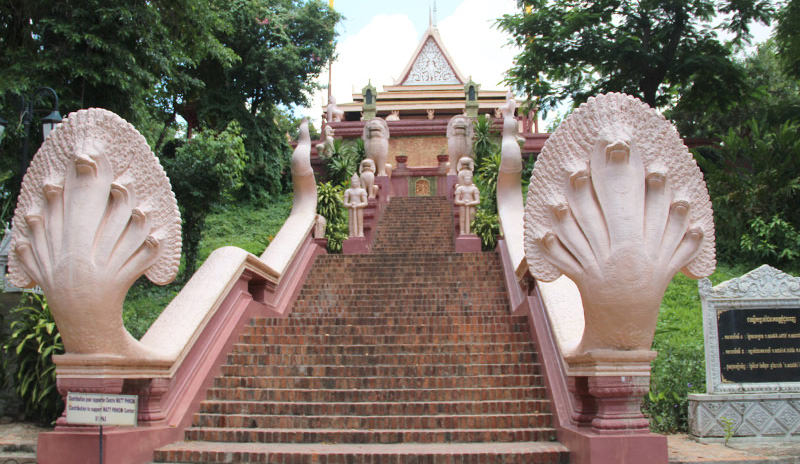 Wat Phnom is a delicate, pretty temple built in a quiet garden.
Wat Phnom is a delicate, pretty temple built in a quiet garden.
Battambang
Apart from the fun bamboo train ride, the temples in Battambang are nothing less amazing. Under an easier local leadership, many of the temples here were spared severe damage during the Khmer Rouge. The monks are more approachable as there are less foreign visitors seen compared with Siem Reap, so it is a chance of starting a conversation with them and listen to some interesting stories.
Wat Ek Phnom
Located 11 kilometers outside of Battambang, Wat Ek Phnom is an ancient temple surrounded by 18 Bodhi trees and lily ponds, exuding a serene atmosphere in the countryside. Following the village road that leads to the temple, en route you will see an old deserted Pepsi factory, which was abandoned during the Khmer Rouge and now is used to produce rice paper for spring rolls. It costs only $2 for the admission fee, and the experience is well worth the penny. Built in 1027, it has a longer history than Angkor Wat. In the main ground of the temple sits a white, big statue of Buddha. Though savagely looted, Wat Ek Phnom still preserves many fine stone carvings and there is a newly built pagoda, so you will have a great time admiring the exquisite artistry circled by different colours of plants. It is hard to imagine, but the site is a popular venue for family picnic and during the New Year – a wild festival will be on full swing during that period.
Prasat Banan Temple
The ruins of Prasat Banan Temple breaths history, spiritual belief and harmony, ensuring an enjoyable visit to both breathtaking views and impressive carvings. Situated out of town – 25km and around 30 minutes by car, the temple is less visited by international tourists, which means you can enjoy more peaceful moment in this thousand-year-old remain. It takes more than 300 steps to reach the temple as it is located on the top of a mountain. I would suggest taking short breaks during the climb so as to take in the lovely surroundings as well as resting a bit. The workout is worth it, from the top you can have a beautiful view of the Sangker River winding along the banks dotted with sugar palm trees, rice paddies and villages. The mountain range afar is also impressive, leaving some room for guessing what shape of animals it looks like.
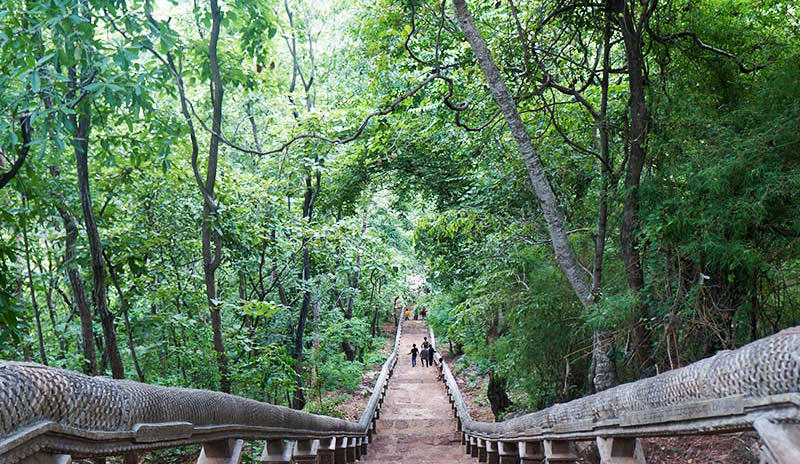 Looking down the staircase from Prasat Banan Temple.
Looking down the staircase from Prasat Banan Temple.
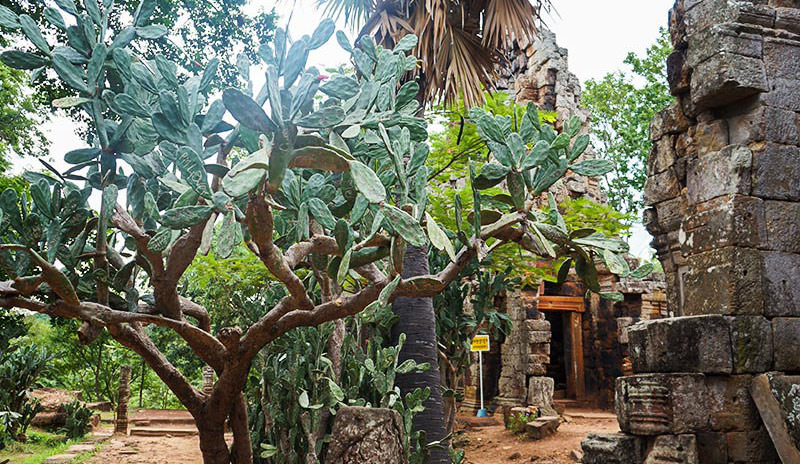 Prasat Banan Temple hides in a small forest of green leaves that provide a cool shelter for visitors.
Prasat Banan Temple hides in a small forest of green leaves that provide a cool shelter for visitors.Preah Vihear
A three-hour drive from Siem Reap, Preah Vihear is a province that partly borders Thailand and Laos. Far from the packed tourist centre, the province houses a series of temples with different style to Angkor Wat but equally impressive.
Preah Vihear Temple
Bearing the same as the province it is located in, Preah Vihear Temple is a four-level Hindu temple that was listed as a UNESCO World Heritage Site in 2008. The temple is built in a pleasant countryside environment, perching on a cliff in the Dongrek Mountains, about 625 meters above sea level. Inside the temple there are four courtyards that consist of five Gopuras and a palace building. Fine carvings depicting outstanding mastery of art can be found, some still remain intact to wow visitors. One of the reasons I find it worth visiting is that the temple presents several architecture styles as it was renovated by different kings throughout history. Another reason for taking a long journey from Siem Reap to here is that you won't have to compete with hordes of people to enjoy some gorgeous views. Seeing the ruins shrouded in the mist and breathing in fresh mountain air is quite an experience, and the best part is being able to get a glimpse of the authentic Cambodian village life.
In short, the temples in Cambodia are overwhelmingly beautiful with a wide range of selection. While some certainly deserve international recognition, a smattering of others, though more remote and less known, are never short of selling points either. All of our Cambodia itineraries can be personalized to suit your interest and time.
Quick Question
What Our Clients Say
Explore the latest verified reviews of Odynovo's travel services on Tripadvisor, Google, Trustpilot, Product Review and more trusted platforms.
SUBSCRIBE TO WIN A FREE TOUR
Subscribe to our newsletter for a chance to win a free 7-day tour to India! And more insider travel news, exclusive offers, and inspiration will be sent straight to your inbox. Check our previous newsletters and get some sparks.

